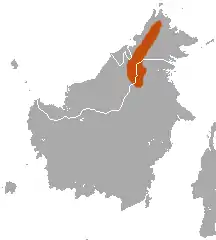Borneo fruit bat
The Borneo fruit bat (Aethalops aequalis) is a species of megabat found in the mountains of Borneo, specifically East Malaysia and Brunei. It is considered a subspecies of Aethalops alecto by some authors.[1]
| Borneo fruit bat[1] | |
|---|---|
| Scientific classification | |
| Kingdom: | Animalia |
| Phylum: | Chordata |
| Class: | Mammalia |
| Order: | Chiroptera |
| Family: | Pteropodidae |
| Genus: | Aethalops |
| Species: | A. aequalis |
| Binomial name | |
| Aethalops aequalis G. M. Allen, 1938 | |
 | |
| Borneo fruit bat range | |
The Borneo fruit bat typically roosts in small groups in trees, under banana leaves, palm fronds and man-made structures. [3]
Taxonomy
The Borneo fruit bat was described in 1938 by American zoologist Glover Morrill Allen. The holotype was collected in 1937 in Mount Kinabalu, Malaysia, which is on the island of Borneo. It was collected by J. Augustus Griswold, Jr. while on the Harvard Primate Expedition led by Harold Jefferson Coolidge Jr.[4] The Borneo fruit bat has, at times, been considered a synonym of the pygmy fruit bat.[5] As of 2019, the prevailing consensus is that the Borneo fruit bat is indeed a separate species.[6]
Description
This bat is physically described as having reddish-brown fur with lighter coloring along the ventral side. The fur is longer along the back of the bat. It has a long, pointed snout. As one of the smallest of the Old World fruit bats, the Borneo fruit bat has a forearm length between 42mm and 46mm.[7]
Range and habitat
The Borneo fruit bat is only found on the island of Borneo, where its range includes Brunei, Indonesia, and Malaysia. It is found in areas of high elevation, and has not been documented lower than 550 m (1,800 ft) above sea level.[2]
Conservation
As of 2016, the Borneo fruit bat is listed as a least-concern species by the IUCN—its lowest conservation priority. It meets the criteria for this classification because it has a large geographic range, across which it is relatively common.[2]
References
- Simmons, N.B. (2005). "Order Chiroptera". In Wilson, D.E.; Reeder, D.M (eds.). Mammal Species of the World: A Taxonomic and Geographic Reference (3rd ed.). Johns Hopkins University Press. pp. 312–529. ISBN 978-0-8018-8221-0. OCLC 62265494.
- Jayaraj, J.V.K.; Struebig, M.; Tingga, R.C.T. (2016). "Aethalops aequalis". IUCN Red List of Threatened Species. 2016: e.T136541A21977630. doi:10.2305/IUCN.UK.2016-2.RLTS.T136541A21977630.en.
- Mohd-Azlan, J (Winter 2010). "Preliminary assessment of activity pattern and diet of the lesser dog faced fruit bat Cynopterus brachyotis in a Dipterocarp Forest, Sarawak, Borneo". Tropical Ecology. 51: 297–302 – via Web of Science.
- Allen, G. M. (1938). "A New Pygmy Fruit Bat from Borneo". Journal of Mammalogy. 19 (4): 496–498. doi:10.2307/1374243. JSTOR 1374243.
- Nowak, Ronald M.; Pillsbury Walker, Ernest (1999). Walker's Mammals of the World. Volume 1. JHU Press. p. 291. ISBN 9780801857898.
- "Aethalops". ASM Mammal Diversity. Retrieved 17 April 2019.
- Freier, Sarah. "Aethalops aequalis (Borneo fruit bat)". Animal Diversity Web. Retrieved 2019-04-13.
